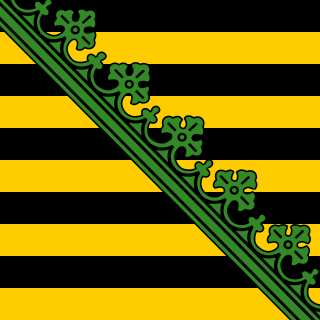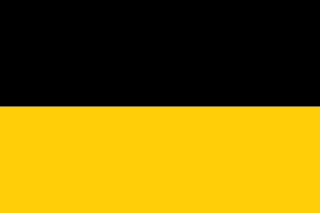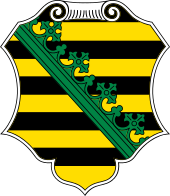
Saxony, officially the Free State of Saxony, is a landlocked state of Germany, bordering the states of Brandenburg, Saxony-Anhalt, Thuringia, and Bavaria, as well as the countries of Poland and the Czech Republic. Its capital is Dresden, and its largest city is Leipzig. Saxony is the tenth largest of Germany's sixteen states, with an area of 18,413 square kilometres (7,109 sq mi), and the sixth most populous, with more than 4 million inhabitants.
Elections in Germany include elections to the Bundestag, the Landtags of the various states, and local elections.

The Duchy of Saxe-Wittenberg was a medieval duchy of the Holy Roman Empire centered at Wittenberg, which emerged after the dissolution of the stem duchy of Saxony. The Ascanian dukes prevailed in obtaining the Saxon electoral dignity until their duchy was finally elevated to the Electorate of Saxony by the Golden Bull of 1356.

The new federal states of Germany are the five re-established states of former East Germany that acceded to the Federal Republic of Germany with its 10 states upon German reunification on October 3, 1990.

The Treaty of Leipzig or Partition of Leipzig was signed on 11 November 1485 between Elector Ernest of Saxony and his younger brother Albert III, the sons of Elector Frederick II of Saxony from the House of Wettin. The agreement perpetuated the division of the Wettin lands into a Saxon and a Thuringian part, which in the long run obstructed the further development of a Central German hegemonic power in favour of Brandenburg-Prussia.
The Politics of Bavaria takes place within a framework of a federal parliamentary representative democratic republic, where the Federal Government of Germany exercises sovereign rights with certain powers reserved to the states of Germany including Bavaria. The state has a multi-party system where the two main parties are the rightist Christian Social Union of Bavaria (CSU) and the leftist Social Democratic Party of Germany (SPD).

Both the civil and state flag of the German state of Saxony feature a bicolour of white over green, similar to the Austrian province of Styria although they are historically not related to each other. The state flag is similar to the civil flag, except it is defaced in the centre with the coat of arms of Saxony. The colours of both flags were officially decided as state colours in 1815. The aristocracy used mostly and in first time the quadrangular and later the rectangular

The Pirate Party Germany, commonly known as Pirates, is a political party in Germany founded in September 2006 at c-base. It states general agreement with the Swedish Piratpartiet as a party of the information society; it is part of the international movement of pirate parties and a member of the Pirate Parties International. In 2011-12, the party succeeded in attaining a high enough vote share to enter four state parliaments and the European Parliament. However, their popularity rapidly declined and by 2017 they had no representation in any of the German state parliaments. Their one European MEP, Patrick Breyer, has joined the Greens/EFA group. Together with Marcel Kolaja, Markéta Gregorová and Mikuláš Peksa from the Czech Pirate Party they build up the European Pirate Party team for the European Parliament in Brussels.
The Old Social Democratic Party of Germany, known as the Old Social Democratic Party of Saxony until 1927, was a political party in Germany. The party was a splinter group of the Social Democratic Party of Germany (SPD) in Saxony, and had nationalistic tendencies. Whilst the party failed to become a mass party, it played a significant role in state politics in Saxony during the latter half of the 1920s. A leader of the party, Max Heldt, served as Minister-President of Saxony 1926-1929. Wilhelm Buck was the chairman of the party.

The Evangelical-Lutheran Church of Saxony is one of 22 member Churches of the Evangelical Church in Germany (EKD), covering most of the state of Saxony. Its headquarters are in Dresden, and its bishop has his or her seat at Meissen Cathedral.

The German Party was a national-conservative political party in West Germany during the post-war years.

Erich Matthias Rößler is a German politician, member of the CDU. Since 1990, he has been a member of the Saxon Landtag. From 1994 to 2004 he served as minister of culture, later as minister of science and art in the government of Saxony. Since 2009 he has been "Landtagspräsident", the speaker of the Saxon parliament.

The 2017 Lower Saxony state election was held on 15 October 2017 to elect the 18th Landtag of Lower Saxony. The incumbent coalition government of the Social Democratic Party (SPD) and The Greens led by Minister-President Stephan Weil was defeated. Though the SPD became the largest party in the Landtag, their gains were offset by losses for the Greens, depriving the government of its majority. The SPD subsequently formed a grand coalition with the Christian Democratic Union (CDU), and Weil continued as Minister-President.

The State of Saxony-Anhalt was a subdivision of the Soviet occupation zone and state of East Germany which corresponds widely to the present-day German state Saxony-Anhalt. After the retreat of the US troops from the Western parts - following the agreements of the Yalta Conference - it was formed as administrative division called Province of Saxony by the Soviet Military Administration in Germany (SMAD) in July 1945. The province was a re-establishment of the Province of Saxony which existed in Prussia from 1816 to 1944. On 1 July 1944, the Province of Saxony was divided along the lines of its three government districts of Halle-Merseburg, Magdeburg and Erfurt. The two provinces became part of the new state including small parts of Thuringia (Allstedt) and Soviet-occupied parts of Anhalt (Dessau) and Brunswick. Following the first election for the Landtag in October 1946, the state was renamed to Province of Saxony-Anhalt on the same day. With the abolition of Prussia in February 1947, it was named State of Saxony-Anhalt. Compared to the administrative divisions of Nazi Germany, it comprised the Gaue Magdeburg-Anhalt, Halle-Merseburg and small parts of Southern Hanover-Brunswick and Thuringia.

The 2019 Saxony state election was held on 1 September 2019 to elect the members of the 7th Landtag of Saxony. The incumbent grand coalition of the Christian Democratic Union (CDU) and Social Democratic Party (SPD) led by Minister-President Michael Kretschmer was defeated, losing its majority. The CDU subsequently formed a "Kenya coalition" with The Greens and the SPD, and Kretschmer was re-elected as Minister-President.

The 2019 Brandenburg state election was held on 1 September 2019 to elect the members of the 7th Landtag of Brandenburg. It took place on the same day as the 2019 Saxony state election. The incumbent government of the Social Democratic Party (SPD) and The Left, led by Minister-President Dietmar Woidke, was defeated. Both parties suffered significant losses, as did the Christian Democratic Union (CDU). Alternative for Germany (AfD) doubled its number of seats and moved into second place. The Greens also made gains, as did the Free Voters.

State elections were held in the Soviet occupation zone of Germany on 20 October 1946 to elect the state legislatures of Mecklenburg-Vorpommern, Brandenburg, Saxony, Saxony-Anhalt and Thuringia. They were the only elections held in the future territory of East Germany before the establishment of the German Democratic Republic in 1949.
State elections were held in East Germany on 15 October 1950. They were the last state elections in the country, as the states were dissolved in 1952.

The 1990 Saxony-Anhalt state election was held on 14 October 1990 to elect the members of the first Landtag of Saxony-Anhalt. It was the first election held in Saxony-Anhalt since the reunification of Germany, which took place on 3 October. The Christian Democratic Union (CDU) led by Gerd Gies emerged as the largest party with 39.0%, followed by the Social Democratic Party (SPD) with 26.0%. The CDU formed a coalition with the Free Democratic Party (FDP), and Gies became Saxony-Anhalt's first post-reunification Minister-President.

The 2021 Saxony-Anhalt state election will be held on 6 June 2021 to elect the 8th Landtag of Saxony-Anhalt. The current government is coalition of the Christian Democratic Union (CDU), Social Democratic Party (SPD), and The Greens, led by Minister-President Reiner Haseloff.


















